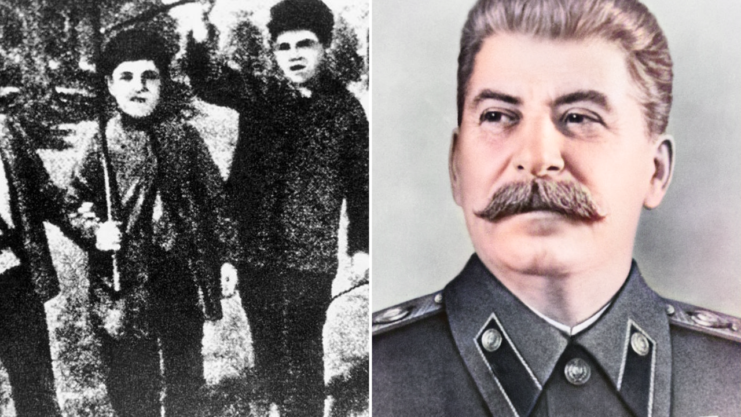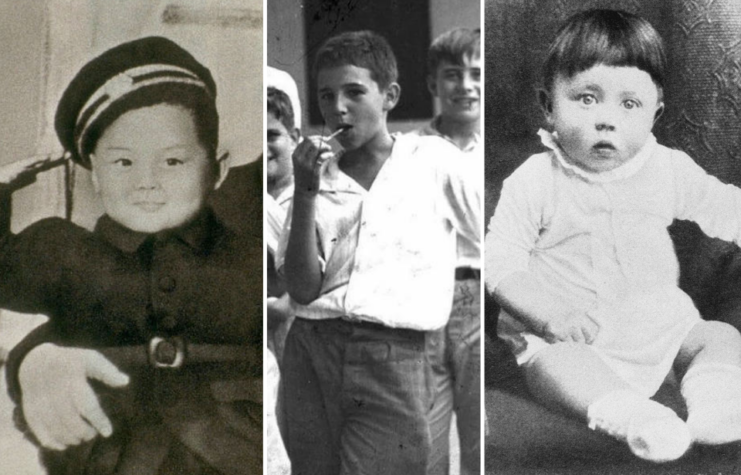If history has shown us anything, it’s that the world has had its share of terrible leaders. While they started out as innocent children, they rose to power – often through forceful means – and forced their ideas upon society, often to its detriment. The following is a list of five of history’s worst as children – do you recognize them?
Joseph Stalin
Joseph Stalin was born on October 18, 1878, in Georgia. He was his parents’ only child to survive past infancy and grew up in relative poverty. His father was an alcoholic and beat Stalin and his mother, leading them to move out of the family home in 1883. The next decade of Stalin’s life was relatively unstable as a result.

 Stalin, aged 12 [L], and as leader of the USSR [R]. (Photo Credit: 1. ullstein bild / Getty Images 2. Bettmann / Getty Images)After being expelled from a seminary in the city of Tbilisi, Stalin became a political agitator, taking part in strikes and labor demonstrations. When Vladimir Lenin died in 1924, Stalin gained control of the Communist Party and became dictator of the Soviet Union.
Stalin, aged 12 [L], and as leader of the USSR [R]. (Photo Credit: 1. ullstein bild / Getty Images 2. Bettmann / Getty Images)After being expelled from a seminary in the city of Tbilisi, Stalin became a political agitator, taking part in strikes and labor demonstrations. When Vladimir Lenin died in 1924, Stalin gained control of the Communist Party and became dictator of the Soviet Union.
Stalin launched a series of five-year plans with the aim of turning the country into an industrial superpower. However, it launched Russia further into poverty, and the resulting famines killed millions. He also took action against his protractors, executing them or sending them to gulags in the north.
Stalin, 1896 [L] and 1894 [R]. (Photo Credit: 1. Hulton Deutsch / Getty Images 2. Universal History Archive / Getty Images)During World War II, he was seen as both an ally and enemy of Hitler. When Nazi Germany fell, he used the instability in Europe to his advantage, pushing the iron curtain across the East and splitting Germany in half. He remained a harsh dictator until his death in 1953.
Fidel Castro
Fidel Castro was born on August 13, 1926 to a veteran of the Spanish-American War. One of seven children, he spent much of his early years moving around, until he was sent to the Jesuit-run Colegio de Belén in Havana in 1945.
Castro as a child [L] and as leader of Cuba [R]. (Photo Credit: 1. Chad_Monke69 / Reddit 2. Sven Creutzmann / Getty Images)Castro was never a strong student but soon became an activist. In 1950, he graduated from the University of Havana and opened a law office, and two years later ran for the Cuban House of Representatives. When Fulgencio Batista seized power, Castro began planning an uprising.
In July 1953, he led over 100 men in an attack on the Moncada army barracks in Santiago de Cuba. He overthrew Batista’s military dictatorship in 1959 and ruled for nearly five decades, before handing down power to his brother, Raúl, in 2008.
Castro, 1943 [L] and 1946 [R]. (Photo Credit: Jose GOITIA / Getty Images)Castro’s regime had its fair share of successes, including the improvement of public healthcare in Cuba, the stamping out of racism and reducing illiteracy. However, this came at the price of the country’s economic and political freedom, as well as Cuba’s relationship with the United States.
Adolf Hitler
Adolf Hitler was born on April 20, 1889, in Austria. From an early age, he and his father fought, as he refused to conform to the strict discipline of his school. This led to regular beatings, from which his mother tried to protect him.
Hitler as an infant [L] and as leader of the Third Reich [R]. (Photo Credit: Bettmann / Getty Images)Hitler eventually dropped out of school and tried to pursue a career as an artist. When he was rejected from Vienna’s Academy of Fine Arts, his interests moved to politics. After serving in the German Army during World War I and upset over the country’s loss, he found himself amongst the top officials of the National Socialist German Workers Party, also known as the Nazi Party.
The Beer Hall Putsch in November 1923 established Hitler as a right-wing hero, and the release of his prison manifesto, Mein Kampf, allowed his continued rise and the birth of the Third Reich. This allowed him to spread his ideas of the Aryan race and his anti-semitic attitudes toward Jewish people.
Hitler, aged 10 [L], and during WWI [R]. (Photo Credit: Hulton Archive / Getty Images)What followed was a war of devastating proportions. Millions of Jews lost their lives in concentration camps, Germany invaded numerous European countries and fighting ran six years. When it became evident the Nazis had lost the war, Hitler, his wife and other high-ranking German officials died by suicide.
Benito Mussolini
Benito Mussolini was born on July 29, 1883 in Dovia di Predappio, Italy. The eldest of three children, he often spent time shadowing his father, who was a blacksmith. He was interested in politics early on, given his father’s Socialist leanings, and this influence stayed with him as he rose through the ranks of Italian society.
Mussolini as a child [L] and as Prime Minister of Italy [R]. (Photo Credit: 1. Mondadori Portfolio / Getty Images 2. Keystone-France / Getty Images)In 1902, Mussolini emigrated to Switzerland in order to avoid compulsory military service. While abroad, he studied Friedrich Nietzsche and Georges Sorel. Sorel’s belief in the overthrowing of liberal democracy through violence appealed to the future leader.
In 1915, Mussolini, by then a journalist, joined the Italian Army and fought in WWI. Unhappy with the Treaty of Versailles, he created the Fasci Italiani di Combattimento and began stockpiling weapons. These aided in the success of the Partito Nazionale Fascista, allowing it to mobilize against the government.
Mussolini as a teenager [L] and while at university [R]. (Photo Credit: 1. ullstein bild / Getty Images 2. Mondadori Portfolio / Getty Images)In 1919, he started a paramilitary fascist movement and became prime minister in 1922. When WWII started, he initially disapproved of Hitler’s policies, but the two eventually came together. By 1943, Italians realized they were losing the war and voted Mussolini out of power. The former leader was arrested while trying to flee to Spain, and was executed by firing squad on April 28, 1945.
Kim Jong-Il
Little is known about Kim Jong-Il’s early life. It’s assumed he was born in 1941 at a Soviet military base near Khabarovsk, Russia. In 1948, his father, Kim Il-Sung, became leader of the newly-established Communist nation of North Korea, which was under the older Kim’s control during the Korean War.
Kim Jong-Il with his father, Kim Il-Sung [L], and as the Supreme Leader of North Korea [R]. (Photo Credit: 1. noboru hashimoto / Getty Images 2. Sasha Mordovets / Getty Images)After graduating from university in 1964, Kim Jong-Il rose through the country’s leading political party, the Workers’ Party of Korea. He was appointed to its Central Committee and tasked with ensuring its ideologies didn’t deviate from those of his father. He was also integral to military reform and oversaw North Korea’s Propaganda and Agitation Department.
Following his father’s death in 1994, Kim Jong-Il assumed power, leading to famines that killed millions. The country also experienced severe financial hardship, as Kim wanted to maintain a large military force while working on the development of nuclear weapons.
Kim Jong-Il as a child [L] and with his parents [R]. (Photo Credit: 1. noboru hashimoto / Getty Images 2. Universal History Archive / Getty Images)North Korea kept its distance from other countries while under Kim Jong-Il’s rule. Its relationship was especially tense with the US, which was weary of its nuclear capabilities. Kim died of a heart attack in December 2011 and was succeeded by his son, Kim Jong-Un.




Leave a Comment